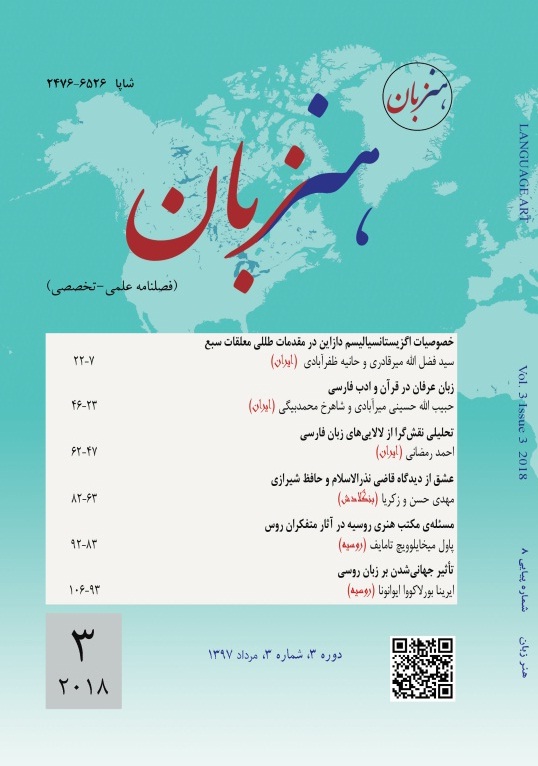زبان عرفان در قرآن و ادب فارسی
DOI::
https://doi.org/10.22046/LA.2018.14کلمات کلیدی:
عرفان، تصوف، قرآن، وحدت وجود، عشق، ولایت، سیروسلوک، فنا و بقا.چکیده
عرفان و تصوف گر چه با هم و معمولا به یک معنا به کار میروند؛ اما عرفان را میتوان جنبهی نظری تصوف و تصوف را نسخهی عملی یا سیر و سلوکی عرفان دانست. برخی پژوهش گران برای تصوف پس از پیدایش، قایل به مرحلهای به نام "جذب"اند که در آن، تصوف عناصری از عرفانهای سایر ملل را در خود جذب کرد و پرورد؛ اما بررسی عناصر بنیادین عرفان اسلامی نظیر وحدت وجود، عشق، ولایت، سیر و سلوک، فنا و بقا و ... و تطبیق آن با قرآن، این نظریه را با چالش رو به رو میکند. ولایت نه تنها نقطهی اتصال عرفان شیعی با اندیشههای ابن عربی و پیروان اوست؛ بلکه نقطه وحدت و چتری است که تمام مشربهای عرفانی را در سایهی خود گرد هم میآورد. همچنین آمیخته بودن علم و عمل یا عرفان و تصوف با یکدیگرو بلکه تقدم داشتن عمل بر نظر و این که دانش عرفان محصول سیر و سلوک و ثبت دریافتهای باطنی است و این در فضای شریعت اسلامی رخ میدهد، تأییدی دیگر بر ابتنای عرفان اسلامی بر قرآن است.
مراجع
Attar Neyshaburi, Farid al-Din. (1977). mantegh al-tair, Tehran: Translation and Publishing Agency.
Attar Neyshaburi, Farid al-Din. (2008). divān. Delaram Pournemati, Tehran: Golsar.
Attar Neyshaburi, Farid al-Din. (2009). mosibatnāmeh.. Introduction, Correction and Propagation by Mohammad Reza Shafiikdekani, Tehran: Sokhan.
Ayati, Abdulhamid (2000). The Holy Quran, Tehran: Soroush.
Chitic, William. (2014). Ibn Arabi vārese anbiyā. Translated by Hushmand Dehghan, Tehran: Payame Emruz.
Ebrahimi Dinani, Gholam Hossein. (2010). daftar-e aql va āyat-e eʃq. Vol. 1, 4th ed., Tehran: Tarh-e No.
Emami, Mohammad Jafar and Mohammad Reza Ashtiani. (2000). nahjul-balaghah, Translation and Explanation, vol.2, 12th ed., Qom: Madrese Al-emam Ali-ibn Abitaleb.
Hafez Shirazi, Shamsalddin Mohammad. (1995). divān, Khalil Khatibrahbar, 17th ed., Tehran: Safi Ali Shah.
Hajvayri, Ali ibn Othman. (1998). kaʃful mahjub. Correcting by Zhukovsky, 6th ed., Tehran: Tahuri Library Publishing.
Hamedani, Einulquzat. (1962). tamhidat. Thanks to Anif Asiran. Tehran: asatir.
Hatef Esfahani, Seyyed Ahmad. (1970). divan. Correcting by Vahid Dastjerdi, Tehran: Foroughi Bookstore.
Hossein Dashti, Seyyed Mostafa (2005). moa’ref va ma’ārif. Vol. 5, Tehran: Araye Cultural Institute.
Ibn al-Arabi, Mohiyid al-Din. (2002). futuhat-e makkiye. Thanks to Abolfazl Afifi, Beirut.
Ibn Arabi, Mohiyiddin. (2016). fusus al-hekam. Transcript, Explanation and Analysis by Mohammad Ali Movahed and Samad Movahed, Tehran: Karnameh.
Khoramshahi, Baha'uddin. (1996). Holy Quran, translation, description and dictionary, Tehran: Jami: Niloofar.
Lahiji, Shamseddin Mohammad (2016). ʃarh-e golʃan-e rāz. Introduction, Correction and Extensions by Mohammad Reza Barzegar Khaleghi, 7th ed., Tehran: Zavvar.
Ma’refat, Mohammad Hadi (2000). tafsir va mofasserān. Qom: al-tamhid.
Makarem Shirazi, Nasser (2003). tafsir nemoneh. Vol. 1, 22th ed., Tehran: Dar al-kutub Islamiyah.
Makarem Shirazi, Nasser (2003). tafsir nemoneh. Vol. 16, 22th ed., Tehran: Dar al-kutub Islamiyah.
Makarem Shirazi, Nasser (2003). tafsir nemoneh. Vol. 23, 22th ed., Tehran: Dar al-kutub Islamiyah.
Meybodi, Abolfazl Rashid al-Din. (1978). kaʃful asrār va eddatul-abrar. by Ali Asghar Hekmat, Vol. 1, Tehran: Amir Kabir.
Moein, Mohammad (1997). farhang-e fārsi. Tehran: Amir Kabir.
Nayyeri, Mohammadiyosof. (2016). narges-e āsheqān. 2nd ed., Shiraz: University of Shiraz.
Pornamdarian, Taghi. (1988). ramz va dāstānhaye ramzi dar adab-e fārsi. Tehran: Scientific and Cultural Publications.
Rajai Bukharaie, Ahmad Ali (1986). farhang-e aʃar Hafez. Tehran: Scientific publications.
Razi, Najmuddin. (1987). Morsad al-ebad, Mohammadamin Riahi, Tehran: Scientific and Cultural Company.
Romi, Jalaluddin (1984). masnavi. Tehran: Pegah Publications
Romi, Jalaluddin (1988). divan shams tabrizi. 12th ed., Tehran: Amir Kabir.
Saadi Shirazi, Moshrefeddin Mosleh ibn Abbas Allah. (1997). kuliyat. From Foroughi's Edition by Mohammad Sadri's, Tehran: Namak.
Sands, Christine. (2016). tafāsir Sufiyane-ye Qur'an. Translated by Zahra Tidindoz, Tehran: Hekmat.
Vali, Shahnematullah. (1994). divan aʃār. Tehran: Ferdows
Zarinkoub, Abdul Hussein. (1984). arzeʃ-e mirās-e sufiye. Tehran: Amir Kabir.
Zarinkoub, Abdul Hussein. (1989). Justu ju dar tassavuf-e Iran. Tehran: Amir Kabir.

